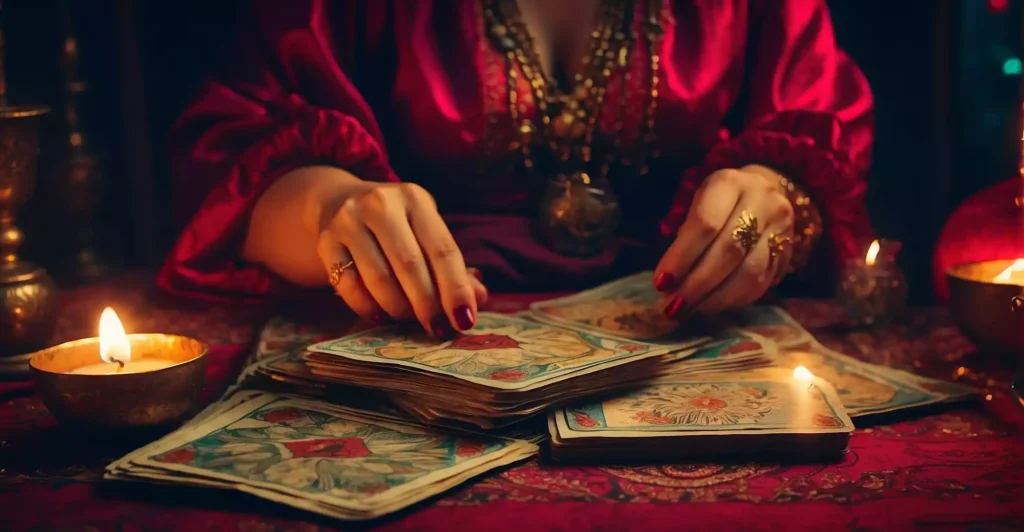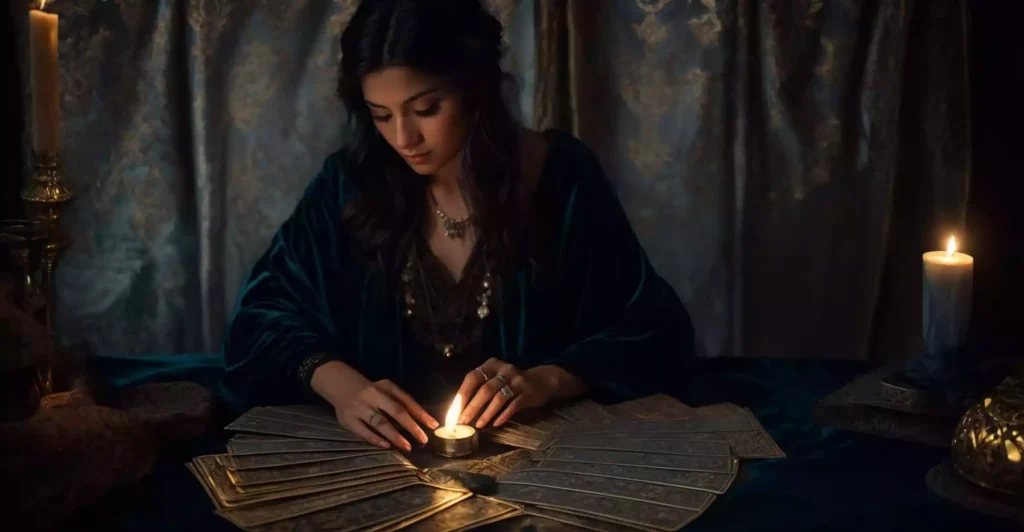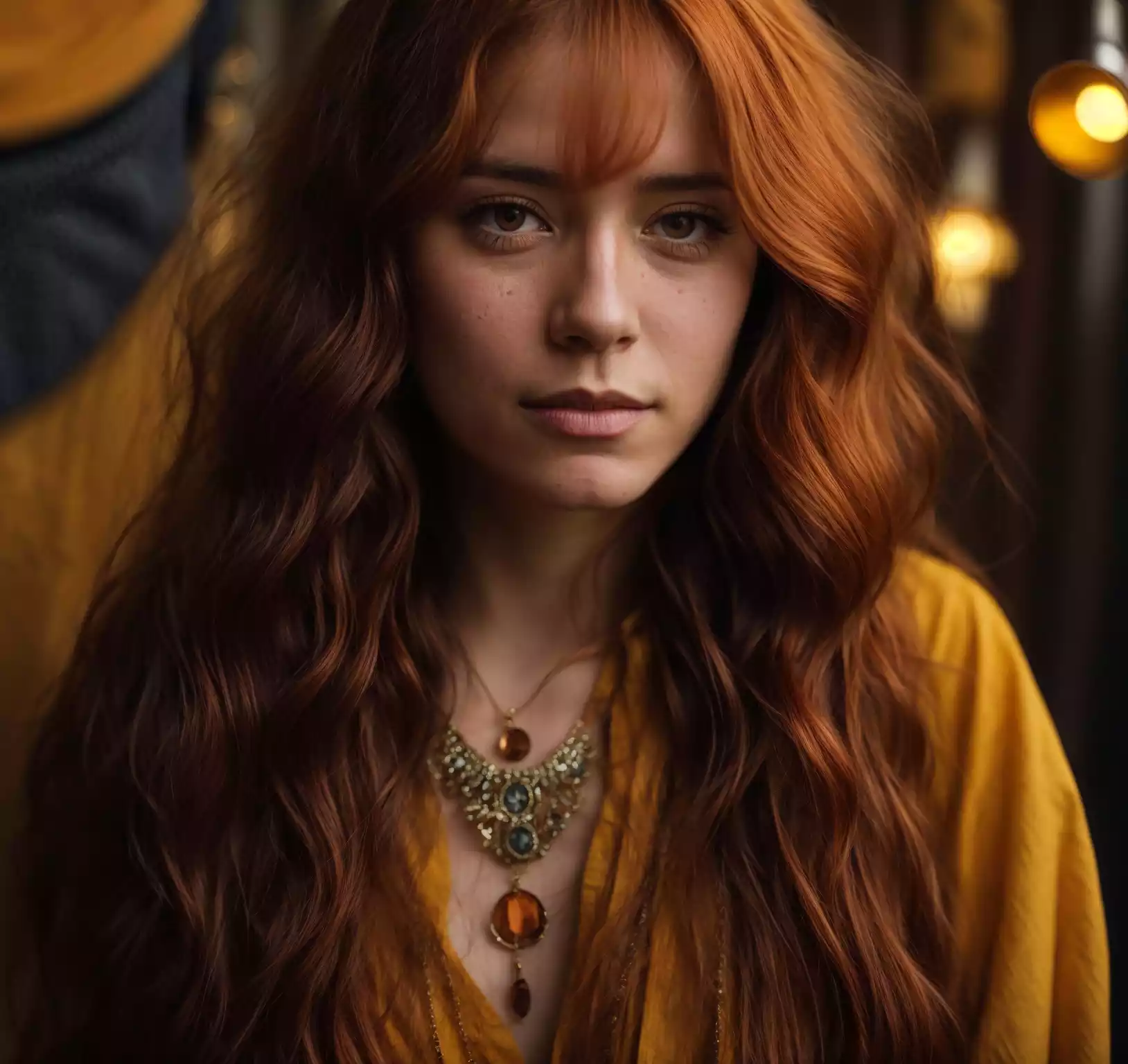Summary
- 1 The 22 Major Arcana
- 1.1 I - The Magician
- 1.2 II - The Papess
- 1.3 III - The Empress
- 1.4 IV - The Emperor
- 1.5 V - The Pope
- 1.6 VI - The Lovers
- 1.7 VII - The Chariot
- 1.8 VIII - Justice
- 1.9 IX - The Hermit
- 1.10 X - The Wheel of Fortune
- 1.11 XI - The Force
- 1.12 XII - The Hanged Man
- 1.13 XIII - Death
- 1.14 XIV - Temperance
- 1.15 XV - The Devil
- 1.16 XVI - The Tower
- 1.17 XVII - The Star
- 1.18 XVIII - The Moon
- 1.19 XIX - The Sun
- 1.20 XX - The Judgment
- 1.21 XXI - The World
- 1.22 XXII - The Fool
- 2 How to calculate the Major Arcana
- 3 History and Origins of the Tarot
- 4 Tarot Readings and Interpretations
- 5 Conclusion
- 6 FAQ - Frequently Asked Questions
The Major Arcana, central elements in the world of tarot, serve as interpretive keys to understanding the profound messages of life. Each card, from "The Fool" to "The Empress," presents rich and complex symbolism essential for divination and personal introspection. Through tarot card reading, individuals explore the cycle of life, addressing themes of personal growth and inner discovery.
Arcana also play a highly important role in the interpretation of the Matrix of Destiny.

The 22 Major Arcana
Do you want to CALCULATE YOUR MAJOR ARCAN?
CLICK HERE!
(completely free calculation!)
I - The Magician
The Magician symbolizes mastery, determination and the ability to turn opportunities into success. It represents the ability to communicate and use one's intelligence to achieve goals.
- STRAIGHT: Creativity, practical skill, willingness, initiative.
- FLIPPED: Deception, lack of direction, indecision.
II - The Papess
The Papess Embodies secret knowledge, intuition and depth. It symbolizes listening to one's inner wisdom and patience.
- STRAIGHT: Intuition, mystery, inner wisdom, understanding.
- FLIPPED: Hidden secrets, disorientation, confusion, superficial.
III - The Empress
The Empress represents creativity, fertility and abundance. It is a symbol of beauty, nature and care, expressing female power and mother earth.
- STRAIGHT: Fertility, abundance, nature, beauty.
- FLIPPED: Dependence, emptiness, disharmony in nature.
IV - The Emperor
The Emperor Symbolizes authority, stable power and control. It represents structure, order and a rational approach to problem solving.
- STRAIGHT: Authority, structure, control, authorship.
- FLIPPED: Tyranny, rigidity, emotional coldness.
V - The Pope
The Pope Represents wisdom, knowledge and counsel. It symbolizes spiritual guidance and moral authority.
- STRAIGHT: Wisdom, counsel, knowledge, morality.
- FLIPPED: Dogmatism, hypocrisy, bad advice.
VI - The Lovers
The Lovers They symbolize love, harmony and moral choices. They represent meaningful relationships and important decisions based on personal values.
- STRAIGHT: Love, harmony, moral choices, union.
- FLIPPED: Disharmony, disagreements, bad decisions.
VII - The Chariot
The Chariot Represents success, determination and overcoming obstacles. It symbolizes control and ambition driven toward goal achievement.
- STRAIGHT: Success, control, ambition, determination.
- FLIPPED: Lack of control, obstacles, aggression.
VIII - Justice
Justice It symbolizes balance, truth and law. It represents the need to make thoughtful and just decisions.
- STRAIGHT: Balance, honesty, justice, truth.
- FLIPPED: Injustice, dishonesty, lack of responsibility.
IX - The Hermit
The Hermit Represents inner wisdom, introspection and the search for truth. It symbolizes the inner guidance and withdrawal from the outside world for spiritual growth.
- STRAIGHT: Introspection, wisdom, inner guidance, solitude.
- FLIPPED: Isolation, loneliness, excessive withdrawal.
X - The Wheel of Fortune
Wheel of Fortune symbolizes change, the destiny And the cycle of life. It represents unexpected opportunities and turns of fate.
- STRAIGHT: Destiny, change, life cycles, opportunity.
- FLIPPED: Bad luck, obstacles, unexpected changes.
XI - The Force
The Force Represents courage, resilience and inner control. It symbolizes the ability to face challenges with calmness and determination.
- STRAIGHT: Courage, determination, inner strength, compassion.
- FLIPPED: Fear, lack of control, weakness.
XII - The Hanged Man
The Hanged Man It symbolizes sacrifice, alternative vision and pause. It represents the ability to see things from a different perspective and patience.
- STRAIGHT: Alternative vision, wisdom, sacrifice, insight.
- FLIPPED: Stalemate, lack of sacrifice, limited vision.
XIII - Death
Death represents the end, transformation and renewal. It does not necessarily symbolize physical death, but rather the end of something and the beginning of a new phase.
- STRAIGHT: End, transformation, renewal, beginning.
- FLIPPED: Stagnation, fear of change, attachment to the past.
XIV - Temperance
Temperance It symbolizes balance, patience and moderation. It represents the ability to combine different elements in harmony and adaptability.
- STRAIGHT: Balance, harmony, patience, cooperation.
- FLIPPED: Disharmony, excesses, lack of long-term vision.
XV - The Devil
The Devil Represents addictions, restrictions and materialism. It symbolizes the chains of attachment and lack of spiritual freedom.
- STRAIGHT: Addiction, materialism, restriction, obsession.
- FLIPPED: Breaking of chains, freedom, revelation.
XVI - The Tower
The Tower symbolizes sudden destruction, revelation and chaos. It represents radical changes and the destruction of false structures.
- STRAIGHT: Radical change, destruction, revelation.
- FLIPPED: Fear of change, disaster averted, resistance.
XVII - The Star
The Star Represents hope, inspiration and serenity. It symbolizes faith in the future and optimism.
- STRAIGHT: Hope, faith, inspiration, serenity.
- FLIPPED: Despair, lack of faith, pessimism.
XVIII - The Moon
The Moon It symbolizes illusion, fear and uncertainty. It represents hidden emotions and the dark aspect of the unconscious.
- STRAIGHT: Uncertainty, illusion, fear, unconscious.
- FLIPPED: Confusion, fear, deception, hallucinations.
XIX - The Sun
The Sun Represents happiness, success and optimism. It symbolizes clarity, vitality and positive energy.
- STRAIGHT: Happiness, success, clarity, vitality.
- FLIPPED: Sadness, pessimism, blocked energy.
XX - The Judgment
The Judgment Symbolizes awakening, judgment and rebirth. It represents understanding, realization and taking stock of one's life.
- STRAIGHT: Awakening, rebirth, realization, judgment.
- FLIPPED: Doubt, remorse, self-condemnation, refusal to let go.
XXI - The World
The World It represents completion, harmony and success. It is the symbol of unity, achievement and fulfillment of goals.
- STRAIGHT: Completion, harmony, success, achievement.
- FLIPPED: Incompleteness, lack of closure, unexceeded limits.
XXII - The Fool
The Fool, traditionally without number or considered the 22nd, symbolizes freedom, beginning and infinite potential. It represents the spiritual journey and surrender to life's experiences.
- STRAIGHT: Freedom, spontaneity, beginning, adventure.
- FLIPPED: Inattention, carelessness, chaos, rash decisions.
How to calculate the Major Arcana
To calculate your Major Arcana, you can use our Major Arcana Calculator.
The calculation is done by birth date, so you can calculate it manually too!
Calculate Major Arcana by hand via date of birth
To calculate your arcane greater manually, follow this guide:
- Sum of Birth Date Numbers: Take your complete date of birth (day, month, year) and add up all the numbers. For example, if you were born on March 15, 1980, the sum would be 1+5+3+1+9+8+0 = 27.
- Reduction to a Single Digit (if necessary): If the result is a number greater than 22, sum the digits again to get a number from 1 to 22. In our example, 27 becomes 2+7 = 9.
- Association with the Major Arcanum: Each number corresponds to a card of the Major Arcana of the tarot. In the case of our example, the number 9 corresponds to the Arcanum "The Hermit." Use a tarot deck or tarot guide to find the card corresponding to your number.
History and Origins of the Tarot
The history of the tarot is shrouded in mystery and fascination. Originally used for play, tarot has evolved over time to become a tool for divination and psychological exploration. Figures such as "The Bagat" (also known as the Magician) and "The Papess" in the tarot are imbued with historical and cultural meanings, reflecting the richness of the traditions and beliefs in which they originated.

Meaning and Symbolism
The meaning of the Arcana is multifaceted and varies according to the context of the reading and personal interpretation. Each card represents an archetype, a universal symbol that speaks to our unconscious. For example, "The Empress" in the tarot symbolizes creativity and fertility, while "The Fool" represents freedom and innocence. These symbols are fundamental to understanding the tarot cycle and its application in daily life.
Tarot Readings and Interpretations
Reading Methods: Spreads and Configurations
Tarot reading is not only an art, but also a science that requires knowledge and intuition. The different spreads or reading configurations offer various perspectives and insights. From the classic "Celtic Cross" to the "Three Card Spread," each configuration is designed to reflect on specific aspects of the consultant's life, from the past to the future, through the prism of the Major Arcana.
Personal vs. Traditional Interpretation
In the practice of tarot reading, there is a balance between personal interpretation and traditional meanings. While cards such as "The Empress" have established historical meanings, their interpretation can vary depending on the reader and context. This aspect makes tarot readings a unique and personal experience, enriched by the relationship between the reader and the consultant.
Practical Use of Tarot in Daily Life
Tarot cards find application in daily life as a tool for reflection and decision-making. In various contexts, from professional matters to personal dilemmas, the cards offer intuitive guidance. The tarot cycle, with its rich symbolism and archetypes, can be a valuable ally in daily choices, providing insight and advice.
Ethical and Moral Considerations in the Tarot
Tarot reading brings with it important ethical and moral considerations. Readers must approach the practice with respect and integrity, aware of the power and influence the cards can exert on people. Responsibility in communicating interpretations, especially in sensitive topics, is critical to maintaining the integrity and honesty of the practice.
Conclusion
The fortune telling, with its rituals and symbols, offers a window into esoteric traditions and man's spiritual understanding. Throughout the centuries, the tarot cycle has influenced not only the practice of divination, but also culture, art and literature, becoming a point of reference in our search for meaning.
Tarot cards invite us to reflect on fundamental questions of existence, offering guidance and support in the challenges of daily life. Their presence in culture and the arts testifies to their relevance and their ability to inspire and be interpreted in ever new ways.
The Major Arcana are not simply cards to be read, but living symbols that speak to each of us in a unique way. Their beauty and power lie in their ability to be mirrors, means of reflection and sources of continuous inspiration, accompanying us on our personal and collective journey of understanding and growth.
FAQ - Frequently Asked Questions
How Can I Begin to Read Tarot Cards?
Beginning the journey of tarot card reading may seem like a daunting task, but it is actually an accessible path for everyone. The first step is to become familiar with the deck, particularly the Major Arcana such as "The Fool in the Tarot" and "The Papessa in the Tarot." Studying the meaning of the Arcana and the symbolism of each card is essential. It is also helpful to keep a journal of the readings to reflect on personal interpretations and feelings.
What is the Meaning of Different Positions in a Reading?
Each position in a tarot reading has a specific meaning, which contributes to the overall narrative. For example, in a simple three-card spread, the first card may represent the past, the second the present, and the third the future. Understanding these positions helps to interpret the cards' messages correctly.
How Can I Distinguish the Interpretations of Different Arcana?
The interpretation of Arcana in the Tarot is a mix of traditional knowledge and personal intuition. Cards such as "The Empress in the Tarot" may have a known general meaning, but interpretation may vary depending on the context of the question and the reader's intuitive connection to the card. Practice and experience will increase the ability to distinguish and interpret the cards correctly.
Can the Tarot predict the Future?
Tarot cards are more a means of introspection and guidance than a simple divinatory tool. Rather than predicting the future in absolute terms, they offer perspectives on possible outcomes based on current dynamics.
